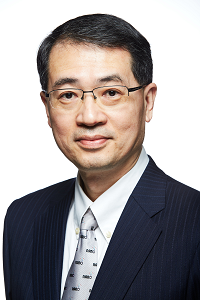
Plenary Speakers

Professor Ming-Chang Lin,
Fellow of Academia Sinica,
Taiwan (R.W. Woodruff Professor Emeritus of Emory University, USA)
Quantum Chemical Simulations of Processes Occurring in ComplexChemical Systems from Combustion to Water Splitting
Selected examples on the merit of quantum chemical simulations for elucidation of complex mechanisms involved in combustion, propulsion and solar water splitting systems will be presented. Specifically, the kinetics and mechanisms for nitrogen oxide formation in hydrocarbon combustion, the combustion initiation reactions in N2O4-hydrazines and ammonium perchlorate propulsion systems, and the synergistic effects of metal doping in TiO2 nanoparticles with hydrogenation for water splitting will be discussed, based on the results from state-of-the-art quantum chemical calculations for comparison with available experimental data.

Professor Kahar Bin Osman,
Chair of School of Biomedical Engineering & Health Sciences,
Universiti Teknologi Malaysia, Malaysia
Customised Stent Design
In some cases, especially in neonates, ductus arteriosus needs to remain patent for multiple medical purposes. In order to achieve this, current practice involves inserting stent in the ductus arteriosus. This condition is called patent ductus arteriosus (PDA). For this process, stents such as coronary stent are commonly used due to unavailability of customized stent for PDA in neonates. The usage of coronary stent however, opens the possibility of acute stent thrombosis and other complications. Therefore, there is a high need of special and customized stents to be used for PDA in neonates. This customized stent has to be able to sustain the hemodynamic effects of the flow inside the PDA. The stent has to be able to support the ductus wall compression and contraction due to arterial compliance. What is more important is that the stent must properly fit into various morphologies of the ductus. In addition, the stent has to be tested for biocompatibility and practicality. Therefore, the customized design of the PDA stents can be derived from the concept of coronary stents and in compliance with all the mentioned characteristics. However, further analysis has to be completed ensure proper compatibility with neonates. In conclusion, the biggest challenge is to customize a stent that fits all the PDA morphologies.
Keynote Speakers

Dong-Sing Wuu*
Fellows of SPIE, OSA, IOP
Department of Materials
Science and Engineering,
National Chung Hsing
University, Taichung 40227, Taiwan
Passive-Matrix Micro-LED
Displays with Advanced Process Integration
The light-emitting diode
(LED) is a self-emissive device with high
response time, brightness, and color saturation
properties. It possesses the high thermal and
humid stability, which is suitable as a next
generation displays. However, for achieving the
high resolution, the pixel size should be
downsized into a few micron scale. In this
study, the pixel size of micro-LED was
investigated from 100×100
μm2 to a 10×10
μm2, where a laser direct writing
technique was employed. The direct writing
technique does not need the photomask and can
improve the exposure accuracy with minimized
image distortion. However, for the smaller pixel
sizes, the plasma damage from the dry-etched
sidewall of pixel became more evident and would
degrade the light extraction efficiency.
Therefore, the surface passivation processes
e.g. spin coating, PECVD, ALD have plays an
important role in determining the leakage
current levels. As a result, the external
quantum efficiency of 10×10
μm2 pixel size can achieve 18.81%
under a current density of 136.8 A/cm2.
The brightness of blue micro-LED display with a
pixel size of 20 x 20 μm2 was 516 cd/m2 at 3 V under the full lighting
state. Using the advanced process integration,
the performance of the blue, green and red
passive-matrix micro-LED displays with 150-250
pixel-per-inch resolution will be described.
Future applications of these small-size
micro-LED displays will also be discussed.

Dr. Srinath Rajagopal,
Senior Research Scientist of National Physical Laboratory,
United Kingdom
Metrology in Medical Ultrasound
The earliest application of ultrasound in medicine dates back to 1940s when its therapeutic effects were demonstrated by successfully destroying brain tissue in animals. It was nearly after a decade later the first diagnostic capability of ultrasound in the detection of breast carcinoma was reported. The ultrasound-induced damage to tissue in therapy did not go unnoticed as the diagnostic use of ultrasound continued to rise in the 1950s and 1960s especially in monitoring of foetal development. In 1980s US Food and Drug Administration initiated the regulation of diagnostic ultrasound equipment. The regulation placed restriction on the ultrasound exposure level, which has been adopted by the manufacturers globally.
The ultrasound exposure levels are quantified by the measurement of the two key quantities, pressure and power. These two quantities represent potential mechanical and thermal damage to tissue under certain excitation conditions. Manufacturers are required to perform measurements under a number of different operational conditions to demonstrate equipment safety. The devices used to make measurements of pressure and power must be traceable to International System of Units (SI) via their calibration at a National Measurement Institute (NMI) for example, National Physical Laboratory, U.K or National Measurement Laboratory, Taiwan.
Hydrophones are used to make the measurement of the dynamic pressure of ultrasound and whereas Radiation Force Balance (RFB) is to measure the ultrasound power. The highest measurement standards applied in the determination of a physical quantity is known as a primary standard. The primary standards for ultrasound pressure and power along with systematic effects, which affect the measurement quality, traceability and dissemination will be described. The emerging technologies in medical ultrasound poses new challenges to measurement and recent efforts to address these challenges will also be covered.